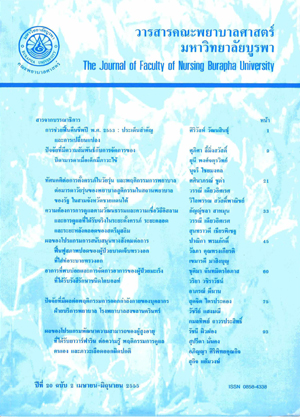ผลของโปรแกรมการสนับสนุนทางสังคมต่อการฟื้นฟูสภาพปอดของผู้ป่วยบาดเจ็บทรวงอกที่ใส่ท่อระบายทรวงอก
คำสำคัญ:
ผู้ป่วยบาดเจ็บทรวงอก, ท่อระบายทรวงอก, การฟื้นฟูสภาพปอด, การสนับสนุนทางสังคม, Chest trauma patients, chest tube drainage, lung rehabilitation, social supportบทคัดย่อ
การวิจัยครั้งนี้เป็นการวิจัยกึ่งทดลอง เพื่อศึกษาผลของโปรแกรมการสนับสนุนทางสังคมต่อการฟื้นฟูสภาพปอดของผู้ป่วยบาดเจ็บทรวงอกที่ใส่ท่อระบายทรวงอก กลุ่มตัวอย่างเป็นผู้ป่วยบาดเจ็บทรวงอกที่ใส่ท่อระบายทรวงอก ที่เข้ารับการรักษาในหอผู้ป่วยศัลยกรรมชายและหญิง โรงพยาบาลเจ้าพระยาอภัยภูเบศร จำนวน 48 ราย แบ่งเป็นกลุ่มควบคุมและกลุ่มทดลอง กลุ่มละ 24 ราย กลุ่มทดลองได้รับโปรแกรมการสนับสนุนทางสังคม กลุ่มควบคุมได้รับการพยาบาลตามปกติ เครื่องมือที่ใช้ในการทดลอง ประกอบด้วย โปรแกรมการสนับสนุนทางสังคม แบบสอบถามข้อมูลทั่วไป แบบบันทึกค่าความจุหายใจ แบบบันทึกจำนวนวันของการคาสายระบายทรวงอก และแบบบันทึกการปฏิบัติกิจกรรมการฟื้นฟูสภาพปอดในผู้ป่วยบาดเจ็บทรวงอกที่ใส่ท่อระบายทรวงอกซึ่ง มีความเที่ยงของค่าสัมประสิทธิ์แอลฟาของคอนบาค เท่ากับ .98 วิเคราะห์ข้อมูลโดยการใช้สถิติพรรณนาและการทดสอบที ( Independent t- test )
ผลการวิจัยพบว่า
1.หลังได้รับโปรแกรมการสนับสนุนทางสังคมค่าคะแนนเฉลี่ยการปฏิบัติกิจกรรมการฟื้นฟูสภาพปอดกลุ่มทดลองมากกว่ากลุ่มควบคุมอย่างมีนัยสำคัญทางสถิติ (t = 7.46, p < .001)
2. หลังได้รับโปรแกรมการสนับสนุนทางสังคมค่าเฉลี่ยความจุหายใจหลังคาท่อระบายทรวงอกกลุ่มทดลองมากกว่ากลุ่มควบคุมอย่างมีนัยสำคัญทางสถิติ ( t = 7.95, p < .001)3. หลังได้รับโปรแกรมการสนับสนุนทางสังคมค่าเฉลี่ยจำนวนวันของการคาท่อระบายทรวงอกกลุ่มทดลองน้อยกว่ากลุ่มควบคุม อย่างมีนัยสำคัญทางสถิติ ( t =10.67, p <.001)
จากผลการศึกษาครั้งนี้ สามารถนำไปประยุกต์เป็นแนวทางในส่งเสริมคุณภาพการดูแลผู้ป่วยบาดเจ็บทรวงอกที่ใส่ท่อระบายทรวงอก รวมถึงทำการวิจัยต่อไป
The purpose of this quasi-experimental research was to examine the effects of social support program for lung rehabilitation in chest trauma patients with chest tube drainage. The sample consisted of 48 chest trauma patients with chest tube drainage who were admitted in surgical ward atChaophrayaAbhaibhubateHospital. The sample was divided into two groups. There were 24 patients in the experimental group receiving social support program and 24 patients in the control group receiving routine nursing care. The instruments consisted of the social support program, demographic questionnaire, vital capacity record form, number of days of chest tube drainage record form, and lung rehabilitation record form. Cronbach’s alpha coefficient of the lung rehabilitation record form was .98. Data were analyzed by using descriptive statistics and independent t – test.
The results revealed as follows:
1. After receiving social support program the mean score of lung rehabilitation in the experimental group was significantly higher than the control group ( t = 7.45 , p < .001) .
2. After receiving social support program the mean of vital capacity in the experimental group was significantly higher than the control group ( t = 7.95, p < .001).
3. After receiving social support program the mean number of days having chest tube drainage in the experimental group was significantly less than the control group ( t =10.67, p <.001).
The findings suggest that the social support program for lung rehabilitation can be used as a guideline to improve quality of care and further exploration the research in chest trauma patients.





